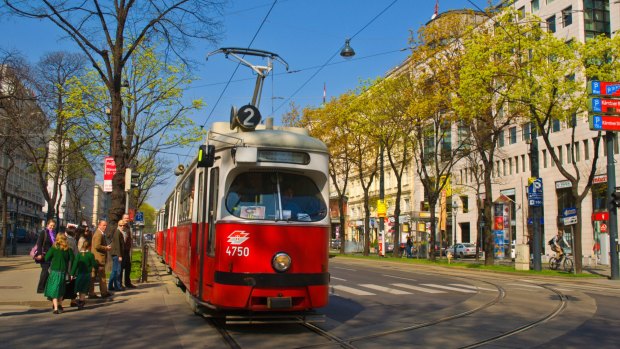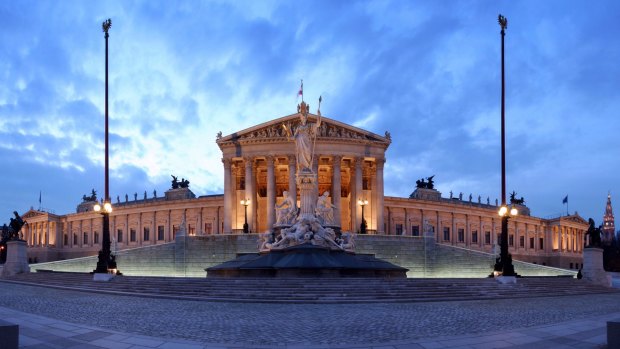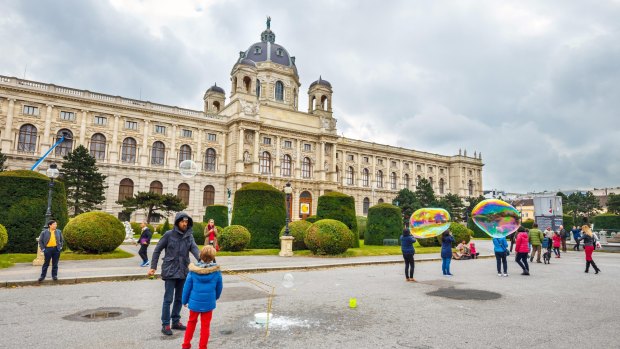This was published 5 years ago
Vienna's Ringstrasse: Palaces, museums, apartment blocks and parks

Operring Ringstrasse street.Credit: Alamy
There's a lot to like about the Ringstrasse. You can keep your Champs-Elysées with its tourist hordes and tatty food outlets, your snooty Fifth Avenue and The Mall in London, more ceremonial carpet than actual avenue. The Ringstrasse is all things to all people: grand and intimate, ornately urban and leafy green, laden with culture but surprisingly relaxed, too.
Unlike many grand boulevards, it doesn't culminate in a single mighty building. The Ringstrasse is a merry-go-round of palaces and museums, apartment blocks and parks. It provides imperial glamour yet suits the modest capital of what's now a little nation. Ride around it on the tram, pedal its cycle paths, walk its promenades, sit on public benches and crane your neck at its ever more startling architecture.
Emperor Franz-Josef presided over the Ringstrasse's opening ceremony in 1865. The city's fortifications had been demolished to make way for a more open, modern city with a swelling population, and the military parade grounds beyond the walls were turned into a five-kilometre looped boulevard.

Paroramic view of the Parliament on Ringstrasse at blue hour.Credit: Alamy
From the start, the Ringstrasse was a huge success. It became the thing to stroll along it, especially between Kärntnerstrasse and Schwarzenbergplatz, the corner of which became the place to rendezvous. Along it carriages clopped and trams rattled. Eventually motor vehicles necessitated Vienna's first traffic lights in 1926. The Ringstrasse is now one of the city's busiest roads, although this isn't always apparent thanks to flanking parks, promenades and overhanging trees.
You could walk the Ringstrasse in an hour, or take the tourist Vienna Ring Tram and plug into headphones for information about sights along the 25-minute loop. Don't forget to look up. The Ringstrasse is an open-air museum of architectural styles, from the ancient Greek (Parliament), Renaissance (State Opera, Natural History Museum) and Gothic (City Hall) to the baroque (Burgtheatre). Statues wave from rooftops and gargoyles leer.
With stops at museums and cafés, however, the Ringstrasse can easily take all day. Start at the Hofburg palace. Skip the elaborate state apartments, whose endless gilt and red silk don't appeal to modern tastes. Better take in baroque's living remnants. The palace features the Spanish Riding School and its white horses, while Hofburg Chapel offers the Mozart music that embodies the zest and wit of the era.

The famous Natural History Museum.Credit: Alamy
Across the road, set back from the Ringstrasse, is the Museums Quarter, where 19th-century palaces and contemporary glass-and-concrete extrusions clash. Free-form benches in jaunty yellow and red are the place to hang out on summer evenings: a sort of open-air salon where students murmur and giggle. If you have limited time, visit just the chamber of curiosities at the Museum of Art History. It's a treasure-trove of Hapsburg collectibles that range from peculiar drinking goblets to mechanical dancing bears, clocks and scientific tools.
Clockwise around the Ringstrasse is Parliament, opposite which is the Volksgarten, heady with roses in summer, and graced with a statue of Empress Elizabeth, ill-fated wife of Franz-Josef. Walk through the park towards the madly neo-Gothic City Hall. Nearby Café Landtmann is one of the great historic cafés of the Ring, and was Freud's favourite hangout. It has a sumptuous wood-panelled interior, brass chandeliers and fantastic outdoor terrace.
Further on at Stubenring, the Ministry of War building represents the last desperate pretention of a failing empire. Its overblown statuary and unrestrained decor contrast with the Post Office Savings Bank across the square, an outstanding example of Modernist architecture in steel and glass that's a world away from the indulgent interiors of Vienna's imperial palaces.
The next stop is the Museum of Applied Arts, in which you can inspect furniture, porcelain and textiles from the same era as the Ringstrasse's founding. Then get some fresh air in the delightful Stadtpark, where statues of composers burst out of the shrubbery, most notably a gilded statue of Johann Strauss the Younger playing his fiddle. A nearby bust of Lehár grimaces in disapproval at Schubert lurking under a tree.
The State Opera is further around the Ringstrasse. Last stop is Burgarten, which returns you to the rear of the Hofburg, which was once the imperial gardens. It has Vienna's only outdoor statue of Franz-Josef, the man who created the Ringstrasse and became something of a monument himself thanks to a long reign. The statue is modest, but the emperor's architectural legacy superb.
TRIP NOTES
MORE
FLY
Emirates flies from Sydney and Melbourne to Dubai (14.5hr) with onward connections to Vienna (5hr 30 min). Phone 1300 303 777; see emirates.com/au
STAY
Sofitel Vienna Stephansdom is an ultra-modern design hotel with a marvellous top-floor restaurant offering sweeping city views. Rooms from €250 per night. Phone 1300 855 975; see sofitel.com
Brian Johnston was a guest of the Austria National Tourist Office and Emirates Airlines.
Sign up for the Traveller Deals newsletter
Get exclusive travel deals delivered straight to your inbox. Sign up now.